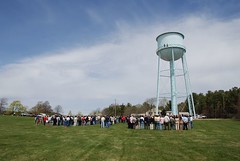

Speaking about how certain things become "invisible" in the online world, and thus nearly cease to exist, what about "audible" things which don't naturally interface to digital realities? Try and wrap your mind around what I'm holding up to my iMac: an
audio tape of talks from one of the first Quark Matter conferences, held at BNL in 1983. These are perhaps
the most important conferences in the field (although clearly the QM2002 organizers didn't think so...), and have been running since 1982.
My colleague, and BNL physicist, Carla found these in her office where they'd been sitting for 24 years -- in a box on the shelf. I spoke to graduate students yesterday who weren't even
born when this happened. They might not have even known what to do with these things, although they might not be able to afford a car without something that can play them. Fortunately my car (a trusty Golf IV) still has one too (good for my iPod, natch), meaning I could drive home listening to the late
David Schramm speak about the importance of heavy ion physics to Big Bang physics (via its help in forming Jupiter-mass black holes) and
Piet Hut on "Disturbing the Vacuum" -- yes, the ur-RHIC-as-Doomsday story.
We are where we are now at RHIC because of what went on in the room when this tape was made. Even more, it's simply gripping hearing the past speak to you so directly (there's a lot that doesn't make it into the written proceedings, and memory is fleeting) and profoundly moving (didn't I mention the memory thing already?). I'm hoping these things can be made digital ASAP.
 Sometimes one wonders why physicists tend to be prime candidates for banks and consulting firms. Then one sees a case like Paul So, a prof at George Mason University, outside of Washington DC.
Sometimes one wonders why physicists tend to be prime candidates for banks and consulting firms. Then one sees a case like Paul So, a prof at George Mason University, outside of Washington DC.














